How To Grow And Care For Horse Chestnut (Buckeye)
This showy spring-blooming tree is both an ornamental and shade tree.
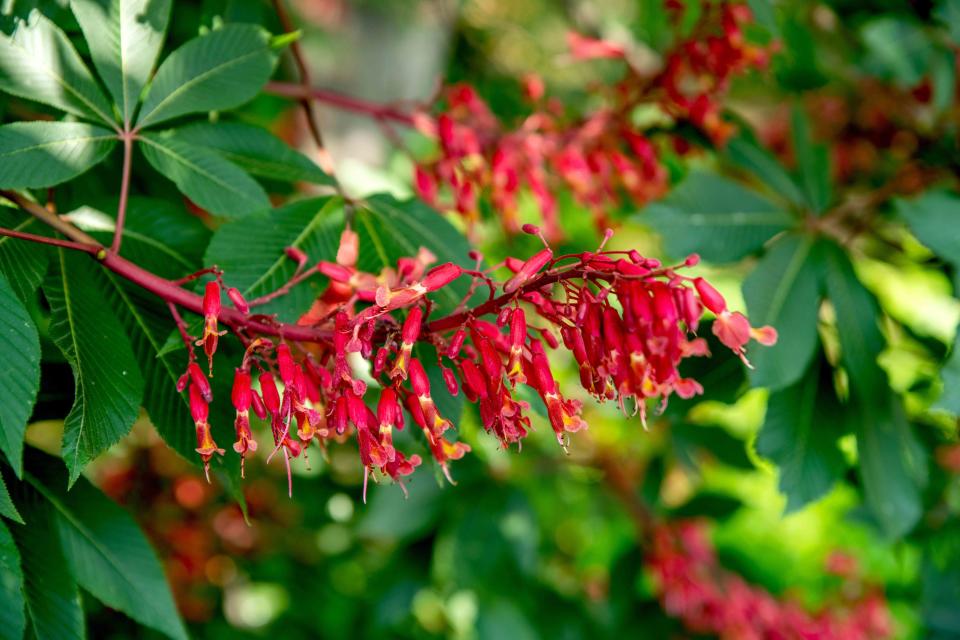
Southern Living/Adrienne Legault
The common horse chestnut tree grows beautifully in Upper and Middle South gardens, Zones 6-7 (USDA). Although native to Europe, this tree grows 60 ft. tall and 40 ft. wide with bulky and dense foliage, a perfect tree for adding shade to parks and walkways. The leaves are divided into five to seven toothed, 4- to 10 inches-long leaflets and put on a spectacular flower show with one foot plumes of white blooms with pink markings. Leathery capsules release glossy, dark brown, chestnut-like seeds (buckeyes) in autumn. Prune established horse chestnuts only to remove dead branches. The horse chestnut’s invasive roots can break up sidewalks. Some varieties of horse chestnut develop good fall color.
Plant Attributes
Common Name | Horse chestnut tree |
Botanical Name | Aesculus hippocastanum |
Plant Type | Tree |
Mature Size | 50-75 ft. high, 40-70 ft. wide |
Sun Exposure | Full, partial |
Soil Type | Moist, well-drained |
Soil pH | Neutral |
Bloom Time | Spring |
Flower Color | Pink, white |
Hardiness Zones | Choose from Zones 4-7 (USDA) |
Native Area | Europe |
Toxicity | Toxic to dogs, toxic to cats |
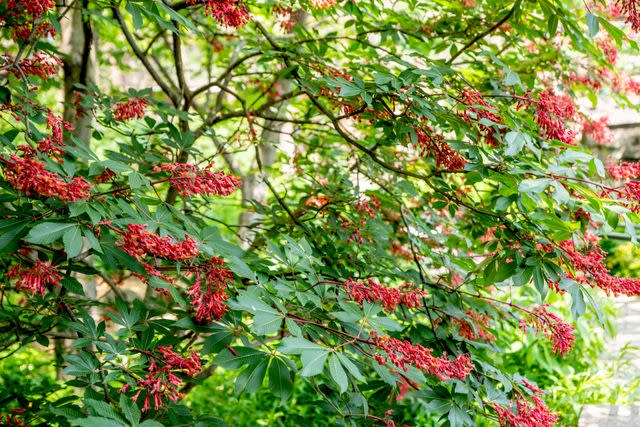
Southern Living/Adrienne Legault
Plant Care
There are many varieties of horse chestnut, so it’s worth exploring this family to find the tree or shrub that works best for your landscape. The common horse chestnut (buckeye) is an easy grower that performs well in a variety of situations, in a variety of soils, and with mixed lighting. It grows at a medium rate, adding about 1 to 3 feet in new growth every year. This deciduous tree fruits with seed that grows inside a prickly husk. It’s poisonous, so we recommend wearing gloves when handling; never eat the horse chestnut. The tree drops its leaves in the fall, so it likely requires some fall clean up depending on where its planted.
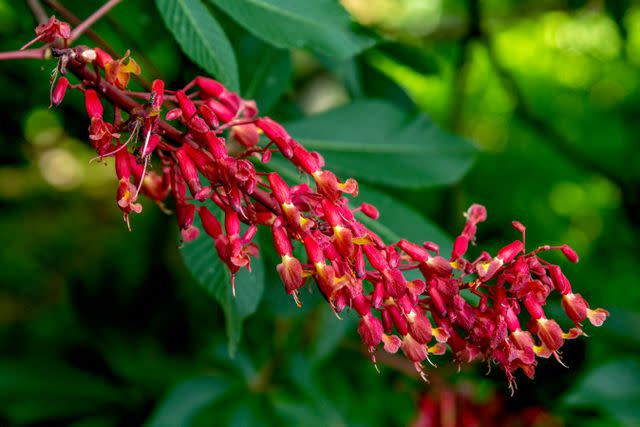
Southern Living/Adrienne Legault
Light
Horse chestnut needs 2-6 hours of direct sunlight every day. Plant it where it will receive both full sun and some shade.
Soil
The horse chestnut tree is a champ, growing in a variety of soil types including acidic and alkaline soils. Keep the soil moist and make sure it drains well.
Water
Horse chestnut will grow best when soil is kept moist. In fact, it won’t tolerate dry conditions well. When establishing a new tree, water it well after you plant it and continue to water weekly through the summer.
Fertilizer
Fertilize the horse chestnut regularly as it becomes established. You can use liquid, granular, stakes, or organic manure. Follow package directions. Once established, fertilize the tree annually in the spring.
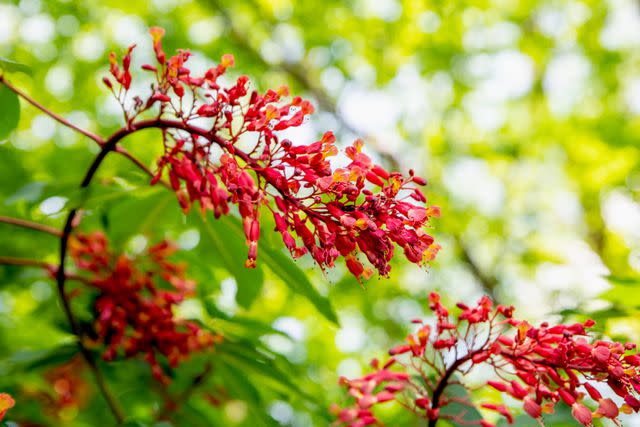
Southern Living/Adrienne Legault
Types of Horse Chestnut
Aesculus X Arnoldiana 'Autumn Splendor grows in Zones 6-8 (USDA), in US, MS, and LS. An attractive hybrid of Aesculus flava, Aesculus pavia, and Aesculus glabra. Grows to 35-40 ft. tall and nearly as wide. Glossy, dark green leaves with five (rarely seven) leaflets turn brilliant maroon in autumn and are resistant to leaf scorch. Yellow flowers, each with an orange-red blotch, are borne in clusters to 8 inches long. Best with some shade.
Aesculus X Carnea grows in Zones 6-8 (USDA), in US, MS, and LS. It grows to 40 ft tall and 30 ft wide. Round headed with large, dark green leaves, each divided into five leaflets; casts dense shade. Bears hundreds of 8 inches-long plumes of soft pink to red flowers. Briotii has rosy crimson flowers; 'Fort McNair' blooms rose-pink, and 'O'Neil's Red' has bright red blooms.
Aesculus Flava(Aesculus Octandra) also known as Yellow Buckeye, or Sweet Buckeye, grows in Zones 6-8 (USDA), in US, MS, and LS. Native to the American South. Most majestic of the North American native species: handsome, round-crowned tree to 90 ft. tall and 50 ft. wide, with dark green leaves divided into five to seven finely toothed, 5- to 8 inch-long leaflets. Yellow flowers form on erect panicles; less showy than those of Aesculus hippocastanum. Smooth, brown bark and orange fall foliage.
Aesculus Glabra, also known as Ohio Buckeye, grows in Zone 6-7 (USDA), in US and MS. From the central and eastern U.S. Low-branching tree with dense, rounded form; to 40 ft. or possibly taller, to 30 ft. wide. Early to leaf out. Foliage is bright green when new, matures to dark green, turns yellow to orange in fall. Greenish yellow flowers in 4- to 7-inch clusters. Prickly seed capsules enclose shiny brown buckeyes.
Aesculus G, also known as Texas Buckeye, grows in Zone 6-8 (USDA), in US, MS, and LS. Attractive small tree to 15-20 ft. or taller, 12-15 ft. wide. Leaves divided into seven to nine narrow, pointed, 3- to 5 inches-long leaflets. Pale yellow flowers in late spring. Weight of fruit may bend branches in fall.
Aesculus Parviflora, or Bottlebrush Buckeye, grows in Zone 6-9 (USDA), in US, MS, CS, and LS. Native to southeastern U.S. Shrub to 12-15 ft. tall and wide, spreading by suckers, with dark green leaves divided into five to seven 3- to 8-inch leaflets. Very showy white flower clusters (812 inches tall, 24 inches wide). Bright yellow fall foliage. Good choice for massing, shrub borders, or specimen or understory planting.
Aesculus Pavia, or Red Buckeye, grows in Zone 6-9 (USDA), in US, MS, LS, and CS. Native to eastern U.S. Understory shrub or tree grows to 12-20 ft. tall and as wide, with irregular rounded crown. Glossy deep green leaves with five to seven 3- to 6 inches-long leaflets. Bears narrow, erect 10 inch clusters of bright red or orange-red (rarely yellow) flowers. Does best in light shade. Good choice for warm, humid climates.
Pruning
Most trees benefit from some pruning to give the tre its best shape. If you prune horse chestnut, do it in the early spring or in the fall once leaves have fallen. Remove those branches that are low or crowded.
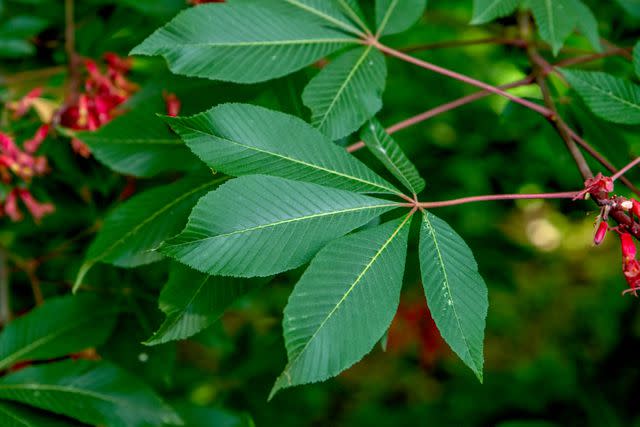
Southern Living/Adrienne Legault
Propagating Horse Chestnut
Propagating a tree requires a lot of patience and time. You can take 4-6 in. cuttings of new wood in the spring or cuttings of hard wood in the fall. Dip the cut end in rooting hormone and place cuttings in a container with soil. If you attempt propagation in the fall, protect the cuttings from freezing. Keep them indoors for protection, yet keep them cool. But if you try and don’t have success, visit your local nursery. It is a sure-fire way to add this tree to your landscape.
Common Pests & Plant Diseases
Two fungi can bother common horse chestnut: leaf blotch and anthracnose. You’ll see leaf blotch on leaves. It presents with reddish-brown spots surrounded with yellow. The infected leaves might curl. To minimize the issue for future growing seasons, rake and dispose of fallen leaves away from your property. Anthracnose presents earlier in the season on new growth wood and leaves. To treat, prune to remove infected twigs.
Pests that bother horse chestnut include Japanese beetles and white-marked tussock moths. To control, spray for the moth’s caterpillar and beetles. Additionally, you can set Japanese beetle traps away from the tree to lure the beetles from the tree. The trap will work to reduce the number of beetles but won’t eradicate them.
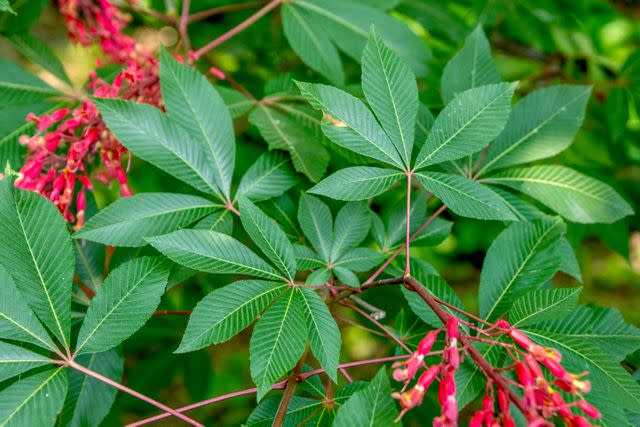
Southern Living/Adrienne Legault
Common Problems With Horse Chestnut
The tree can also have problems with drought, resulting in scorched leaves. To prevent, make sure the tree has regular water while becoming established and during exceptionally dry seasons.
For more Southern Living news, make sure to sign up for our newsletter!
Read the original article on Southern Living.

